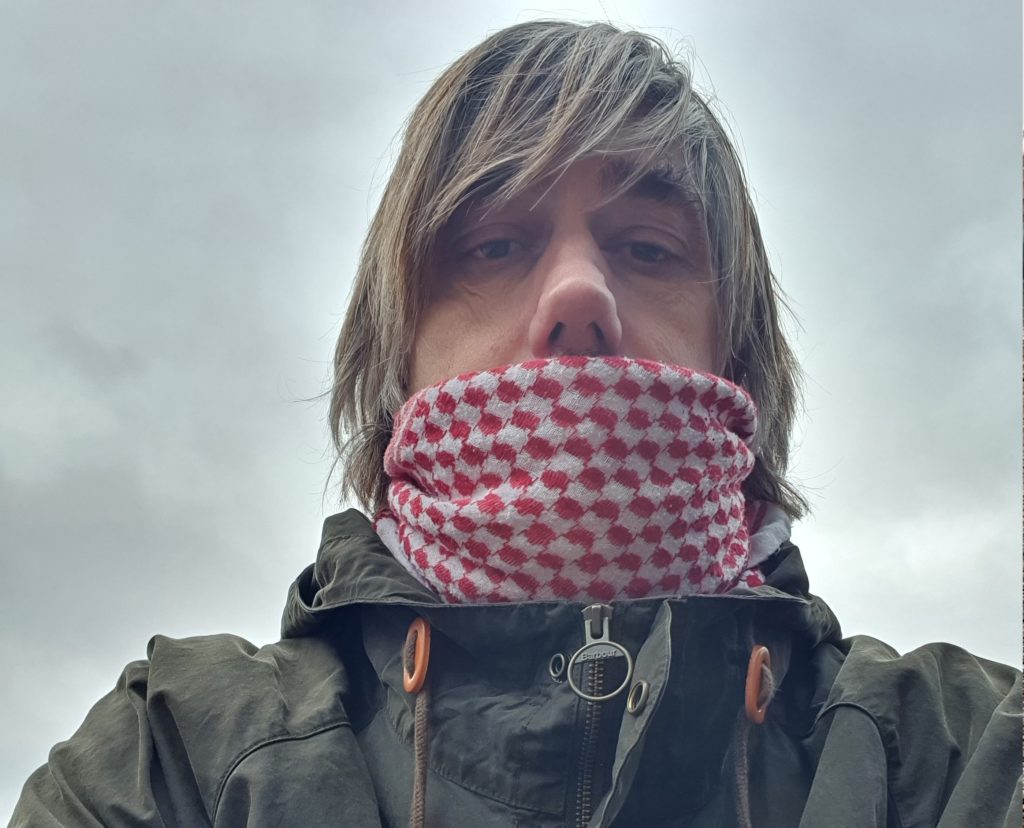
Interview with John Wild for SPACE Art + Tech
- What were you doing in the year leading up to the residency?
Writing up my PhD, Psychogeography in the Digitally Expanded City, dominated the year leading up to the residency.
My PhD research focused on the social, political and environmental impact of digital technology on the felt experience of everyday life. It used experimental artist walking practices as a mode of engagement. For example, a collective walking study focused on following the route of underground fibre-optic cables linking the core data centres that form the London Internet Exchange. The walk mapped the complexity of data-centre relations, which intertwine the micro-extraction of surplus-value from personal data to the macro extraction of fossil fuels, to power its mass storage. Another of my studies investigated the invisibility of digital infrastructures using specially designed radio receivers to make the transmission of communications technologies such as wi-fi, Bluetooth, and mobile phones, audible. Invisibility is a fundamental driver in the philosophy, design and development of ubiquitous and mobile computing. Invisibility enables the use of digital technologies but also has the potential to mask surveillance and the exploitation of personal data. This carries ethical and political consequences as ubiquitous computing becomes a reality and more environments and objects are embedded with computational capacity.
Art practices that explore the affective and aesthetic qualities of digital infrastructure and machine to machine communications can play a valuable role in critically thinking about this problematic. Experiencing the events and walks, allowed the production of alternative poetics of digital infrastructure and inspired new spatial imaginaries. I believe that this is a necessary process in the development of a politics and ethics which are capable of responding to the challenges posed by the proliferation of ubiquitous and mobile computing into urban space.
The SPACE residency has been a fantastic opportunity to broaden my research to include Artificial Intelligence (AI) and Machine Learning (ML) while maintaining an interest in situated and spatial practice.
- What are you working on at the moment?
For the SPACE Art + Tech residency, my research focuses on the Limehouse Foreshore immediately below Canary Wharf. It brings together multiple conflicting systems: The tidal flows of the Thames, growth patterns of green algae, machine learning algorithms used for high-speed trading and electrical signals produced by the brain while daydreaming. I have to credit Anne Bean for introducing me to this location when she invited me to produce work for a Come Hell Or High Water performance event. The ephemeral nature of the location, only accessible at low tide, collides with Canary Wharf, where stock share prices circulate Canada Square on Reuter’s ticker display. Natural forces and human forces become intertwined, conjuring visions of the Anthropocene.
For SPACE, I produced an installation consisting of a computer cooled by a tank of water containing live gutweed, running a machine learning model trained on an original data set of human bodies occupying the Limehouse Foreshore. Viewers are encouraged to wear an EEG headset as they interact with the installation, while data gathered from their brainwaves produces an image unique to each viewer.
The images produced by the ML model, the machinic dreamings, often suggest dark fantasies. Chunks of flesh discarded on the beach, mutated human forms merging with the environment, the possible abandoned residue of Capital’s human meat stranded on the Foreshore between the rising waters of the Thames and the hostile steel and glass of Canary Wharf; surplus to requirements in an era of AI.
Although the Installation is currently inaccessible, I continue to look for alternative ways for people to access my work. I am processing and re-mixing the material gathered and created throughout the SPACE residency. I have recombined some elements into a short illustrated text and a video. The research has produced an abundance of material and ideas which I will continue to rework and reflect on, long after the residency.
- How has the pandemic affected your artistic work?
My work is a physical installation that requires human interaction, which has been rendered impossible to exhibit because of the pandemic. However, an even greater problem has been caused by the lack of access to other people. I have been primarily working with Machine Learning, re-training Generative Adversarial Networks to produce original images. A key element of this creative practice is the production of a data set. Initially, my installation was trained using images of bodies occupying the Limehouse Foreshore, but any subsequent gathering of either sufficient quantity or diversity of images of bodies was prevented by the pandemic working environment. This deficit in the data exposes biases that can easily occur when using Machine Learning, which I think is an important critical lesson. The output of machine learning will only ever be as good as the data it is trained upon. A biased society will train its artificial intelligences in the biases of that society. I am treating my project as a preliminary prototype until it can be trained on a larger and more diverse data set.
- What’s coming next?
I will continuing to work with Artificial Intelligence and Machine Learning.
These technologies are having a profound effect on the present and this will only intensify in the future. I am hoping that when life normalises, I will be able to find the opportunity to exhibit the installation work developed while participating in the SPACE art + Tech residency. Speculative narratives of Artificial General Intelligence (AGI) and its relationship to capitalism interest me. I am currently organising speculative workshops around the ethics and politics of AI with the aim of developing alternative technological and social imaginaries.
I also have a conference paper and publication scheduled for early this year. Streetnotes journal is in the process of publishing my article charting the digitally expanded psychogeographic experiments of CODED GEOMETRY and in June I will be presenting a paper titled, Invisible Geographies – The poetics of digital infrastructure, at the URBAN ASSEMBLAGE conference.